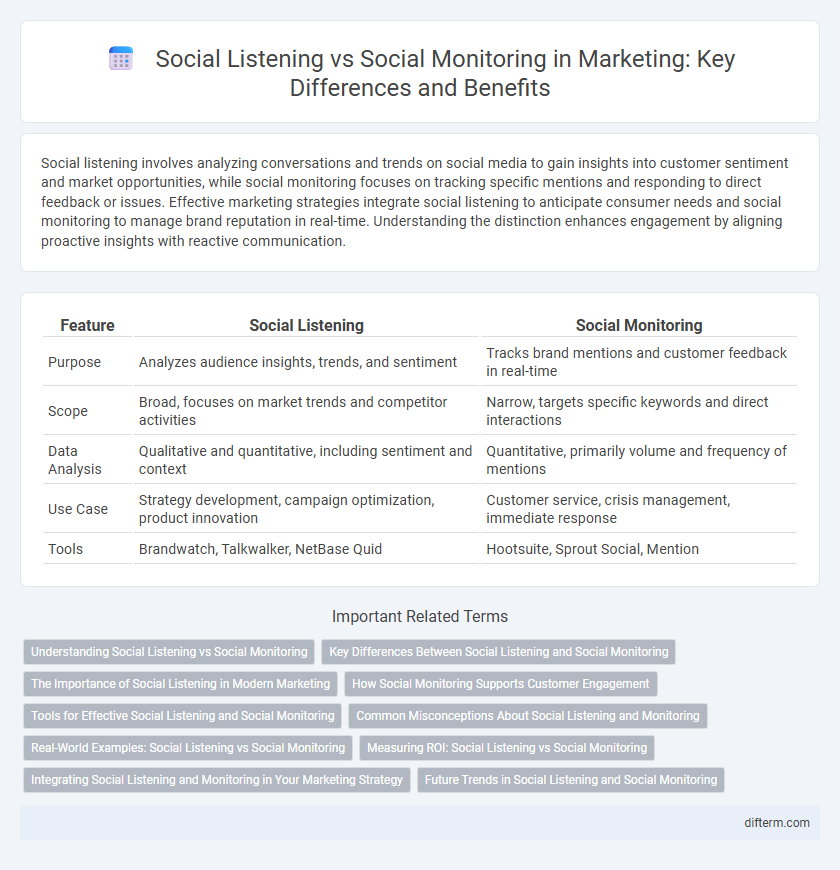Social listening involves analyzing conversations and trends on social media to gain insights into customer sentiment and market opportunities, while social monitoring focuses on tracking specific mentions and responding to direct feedback or issues. Effective marketing strategies integrate social listening to anticipate consumer needs and social monitoring to manage brand reputation in real-time. Understanding the distinction enhances engagement by aligning proactive insights with reactive communication.
Table of Comparison
| Feature | Social Listening | Social Monitoring |
|---|---|---|
| Purpose | Analyzes audience insights, trends, and sentiment | Tracks brand mentions and customer feedback in real-time |
| Scope | Broad, focuses on market trends and competitor activities | Narrow, targets specific keywords and direct interactions |
| Data Analysis | Qualitative and quantitative, including sentiment and context | Quantitative, primarily volume and frequency of mentions |
| Use Case | Strategy development, campaign optimization, product innovation | Customer service, crisis management, immediate response |
| Tools | Brandwatch, Talkwalker, NetBase Quid | Hootsuite, Sprout Social, Mention |
Understanding Social Listening vs Social Monitoring
Social listening involves analyzing conversations and trends across social media platforms to gain insights into customer sentiment, brand perception, and market opportunities. Social monitoring focuses on tracking specific keywords, mentions, and brand interactions in real-time to respond promptly to customer inquiries and manage reputation. Understanding the distinction enables marketers to leverage social listening for strategic decisions while using social monitoring for tactical engagement and crisis management.
Key Differences Between Social Listening and Social Monitoring
Social listening involves analyzing online conversations to gain insights into consumer sentiment, trends, and brand perception, whereas social monitoring focuses on tracking specific keywords or mentions in real-time to respond promptly. The key difference lies in social listening's strategic approach to understanding broader market dynamics, while social monitoring emphasizes tactical, immediate engagement and issue resolution. Effective marketing strategies integrate both practices to optimize brand awareness and customer relationship management.
The Importance of Social Listening in Modern Marketing
Social listening captures consumer sentiment and emerging trends by analyzing online conversations, offering deep insights beyond basic social monitoring metrics like engagement rates and mentions. Effective social listening enables brands to tailor marketing strategies, improve customer experiences, and proactively address potential crises. In modern marketing, leveraging advanced AI-driven social listening tools transforms raw data into actionable intelligence that drives competitive advantage.
How Social Monitoring Supports Customer Engagement
Social monitoring tracks real-time mentions and conversations about a brand across social media platforms, enabling marketers to respond promptly to customer feedback and inquiries. By identifying trending topics and sentiment shifts, brands can tailor their communication to enhance engagement and build stronger relationships. This proactive interaction fosters trust and loyalty, directly supporting improved customer engagement strategies.
Tools for Effective Social Listening and Social Monitoring
Tools for effective social listening and social monitoring include platforms like Brandwatch, Hootsuite, and Sprout Social, which provide real-time data analysis, sentiment tracking, and keyword monitoring. These tools enable marketers to gain insights into customer opinions, emerging trends, and competitor activities by aggregating data across multiple social media channels. Leveraging AI-driven analytics, they help optimize campaign strategies and improve brand reputation management through actionable metrics.
Common Misconceptions About Social Listening and Monitoring
Social listening is often mistaken for social monitoring, but it extends beyond basic data tracking by analyzing audience sentiment and identifying emerging trends. Unlike social monitoring, which focuses on responding to direct mentions and managing brand reputation, social listening provides strategic insights that inform marketing decisions. Many marketers overlook that social listening requires advanced analytics tools to capture nuanced conversations across multiple platforms, rather than just tracking keywords.
Real-World Examples: Social Listening vs Social Monitoring
Social listening involves analyzing customer sentiment and emerging trends by tracking brand mentions across social media platforms, as demonstrated by Coca-Cola's campaign adjustments based on Twitter feedback. In contrast, social monitoring focuses on real-time tracking of direct interactions and customer complaints, evident in Zappos' rapid response to customer service issues via Facebook and Instagram. Brands leveraging both strategies gain comprehensive insights, improving engagement and strategic decision-making.
Measuring ROI: Social Listening vs Social Monitoring
Measuring ROI through social listening involves analyzing consumer sentiment and trends to guide strategic decision-making and improve brand reputation, providing deeper insights into customer behavior. Social monitoring focuses on tracking brand mentions and direct engagement metrics, offering real-time data for immediate response but limited in assessing long-term impact. Combining social listening and monitoring delivers comprehensive ROI measurement by capturing both qualitative insights and quantitative performance indicators.
Integrating Social Listening and Monitoring in Your Marketing Strategy
Integrating social listening and social monitoring enhances a marketing strategy by combining real-time data tracking with deep sentiment analysis to capture customer insights and industry trends. Social monitoring focuses on tracking specific mentions and metrics across platforms, while social listening interprets broader conversations to inform brand positioning and campaign adjustments. Leveraging both tools allows marketers to respond proactively to consumer needs, optimize content, and drive engagement through data-driven decision-making.
Future Trends in Social Listening and Social Monitoring
Emerging trends in social listening and social monitoring emphasize AI-driven analytics and real-time sentiment analysis to predict consumer behavior with greater accuracy. Integration of multi-platform data streams and enhanced natural language processing enables marketers to uncover deeper insights and respond proactively to market shifts. Future advancements will prioritize automated crisis detection and personalized engagement strategies to optimize brand reputation management.
social listening vs social monitoring Infographic

 difterm.com
difterm.com